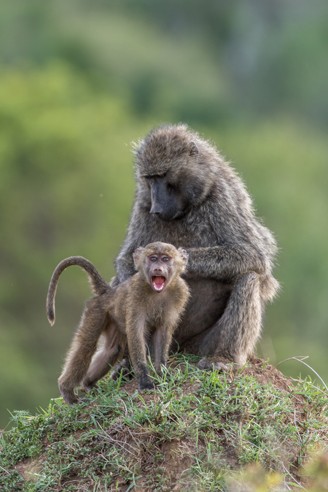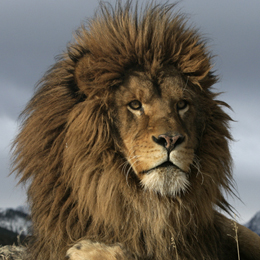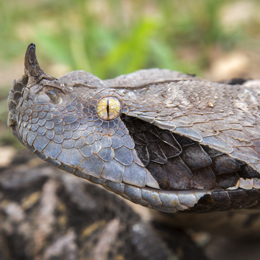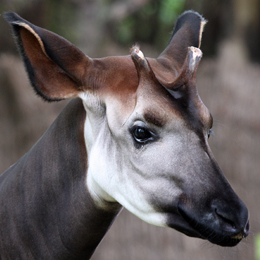Description
Olive baboons have a thick hairy coat, that occurs in a combination of yellow, brown and black hairs all over the body. Collectively, the hairs give an olive-green colored shade to the baboon when looked at it from a distance, therefore, the name Olive Baboon. Olive baboons are also known as Anubis baboons as they have a dog-like muzzle, which is quite similar to that of the Egyptian God named Anubis.
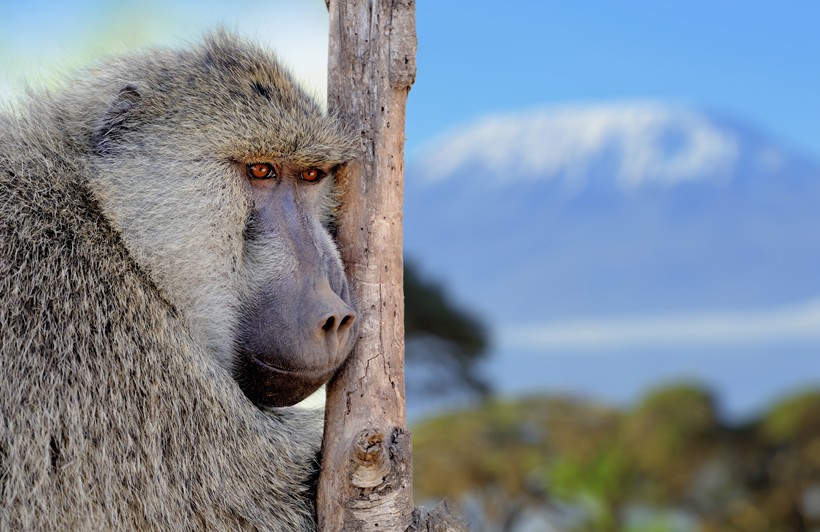
Baboon watching over the savanna, Amboseli National Park of Kenya
?
Image credits: Volodymyr Burdiak/Shutterstock
Like most Old World Monkeys, olive baboons have tails but they cannot use them to grab or hold objects. Instead, the tail has a thick padding, allowing the baboon to use it as a cushion while sitting. Males and females of this species are easily distinguishable by several physical differences. The males are larger in size and have longer hairs on the head and neck region, forming a mane that tapers down to short hairs on its body. An adult male baboon measure up to 70 centimeters while the female has an average height of only 60 centimeters at the shoulder. On average, an adult male baboon weighs 25 Kg and females weigh close to 15 -20 Kg. However, under suitable conditions, dominant males can grow up to 50 Kg in weight.
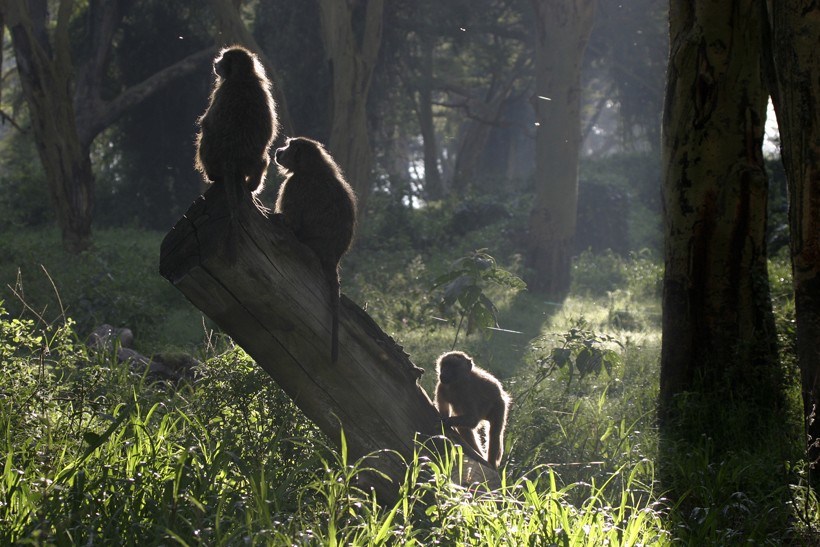
The baboons search for food both on the ground as well as in trees in forests
?
Image credits: Steffen Foerster/Shutterstock
Canine teeth are comparatively small in female olive baboons. Males have long canines that can be up to 2 inches in length. Larger dominant males show sometimes canine teeth longer than that of African lions. Olive baboons have razor sharp senses that allow them to be successful on the grasslands of Africa. Their sense of hearing, smell and sight make them able to pick up the even smallest indications left by an approaching threat. These sharp senses are used also frequently for communication with other baboons in the region.
An Olive baboon can live for 25-30 years in the wild, but a very few manage to live that long, especially due to the predators dwelling in the Africa grasslands and steppe forests. There are five distinct species of the genus Papio consisting of baboons, but there are no recognized subspecies of the species P. anubis.
Habitat & Diet
Olive baboons inhabit steppe forests and grasslands of Africa. Out of all the different species of baboons in Africa, the olive baboon is the most widespread.
Unlike the New World Monkeys, baboons prefer a terrestrial lifestyle. The troop of olive baboons spends most of the day searching the grounds for food and water. They use their human-like hands to find food in the open grasslands. Like all other baboon species, the olive baboon is omnivorous but prefers to depend primarily on a herbivorous diet. They are rarely seen hunting and scavenging for meat, which makes up approximately 33.5% of the total olive baboon diet.
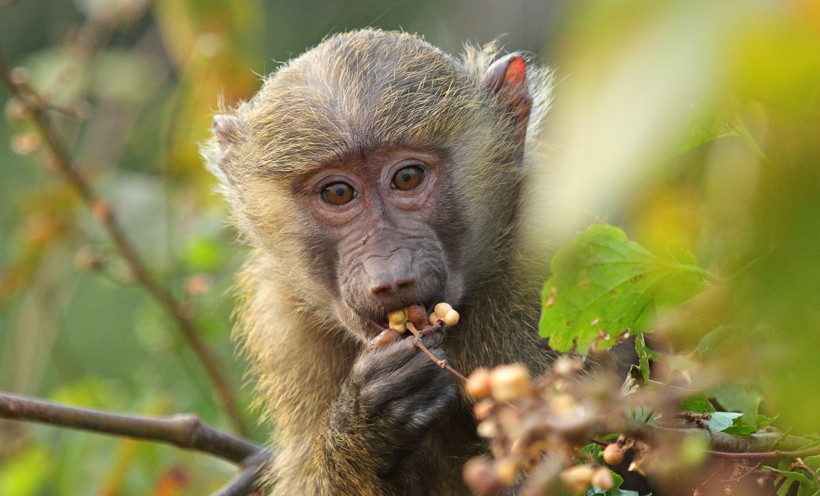
The olive baboon is omnivorous but prefers to depend primarily on a herbivorous diet.
?
Image credits: MattiaATH/Shutterstock
Olive baboons are highly adaptable primates and their dietary habits change according to shifts in the food supply in their habitat. Forest dwelling olive baboons are active climbers. They search for food both on the ground as well as in trees in forests, whereas the baboons living on the grasslands are more terrestrial in nature.
Baboons feed on plant matter such as leaves, grasses, fruits, roots, seeds, mushrooms, tubers and lichens. They also hunt on small vertebrates like rodents and hares to meet their nutritional requirements. Organized hunting has been recently observed among olive baboons. Both females and males of the troop work together and hunt medium-sized prey like the Thomson’s gazelle, sheep, goats and chickens.
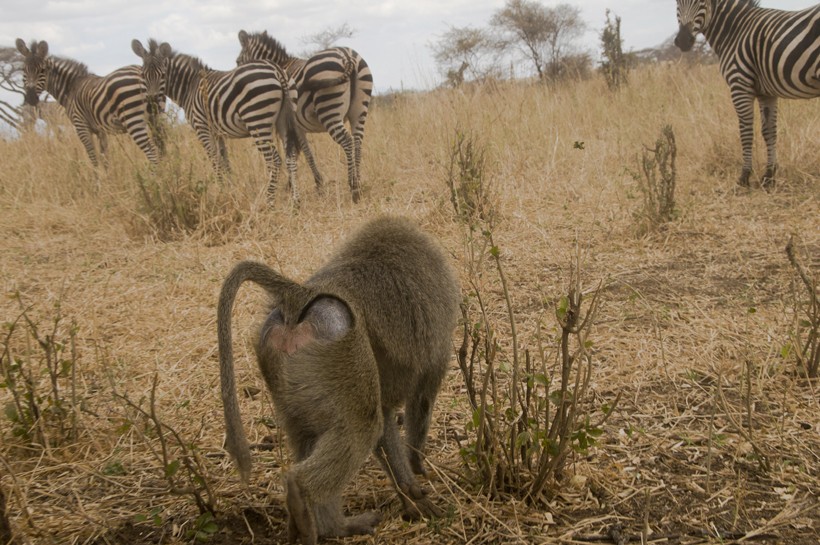
Olive baboon with a herd of zebras in lake manyara national park Tanzania
?
Image credits: City Escapes Nature Photo/Shutterstock
Africa is known for its animal life. The most fascinating among all animals are the deadly predators that live here. Olive baboons have to match with some of the deadliest predators on earth in order to survive in Africa. Lions, leopards, hyenas, nile crocodiles and cheetahs can all easily take down a baboon on the ground. As a defensive measure, baboons are always alert. They send alarm calls to the rest of the troop as soon as they sense a threat lurking close. The baboons also use trees as a higher ground to spot predators from a distance.
When a potential threat is detected, the troop olive baboons quickly find refuge in nearby trees. However, in sticky situations, an attack is the best defensive strategy in a baboon’s arsenal. In such situations, the troop aggressively charges towards the predator, displaying their long canines. With strength in numbers, jaws and arms, the troop of baboons is well capable of fending off any predator in the olive baboon habitat. However, the deadliest of all, are the humans. Tribal people living on the grasslands of Africa are known to hunt on baboons as they are available in large numbers.
Reproduction and Lifecycle
A female olive baboon reaches sexual maturity at the age of 7-8 Years while the male is mature between 8-10 years of age. Males leave their troop and join other troops before they reach sexual maturity. As a result, males within a troop are not related to each other and young males maintain an aggressive nature towards other males of the troop during the mating season.
Olive baboons follow a promiscuous mating behavior where males and females of the troop mate with different partners over the mating season. During ovulation, the female experiences sexual swelling, where the anogenital region swells and turn bright-red in color. This acts as a signal to males that the female is ready to mate. Behavioral changes are also observed in both males and females during the mating period. Females with larger sexual swelling are considered to be more fertile than other females. Such females attract many males, resulting in furious conflicts among the males.
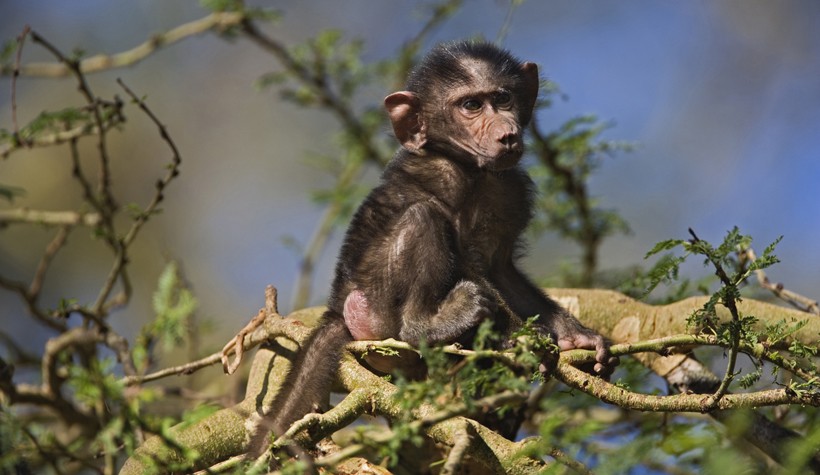
Baby olive baboon, lake nakuru, national park Kenya
?
Image credits: Danita Delmont/Shutterstock
The newborns arrive after a gestation period of up to 6 months. The female gives birth to a single offspring and protects it for the first few weeks. The offspring has a black coat which gradually changes to olive-green as the newborn turns into an adult. At the age of just two weeks, the olive baboon offspring is able to move away from its mother for short periods of time. Females, however, keep their babies close for the first 7-8 weeks. Offsprings from experienced and high-ranking females show a better survival rate compared to offsprings born to first-time mothers.
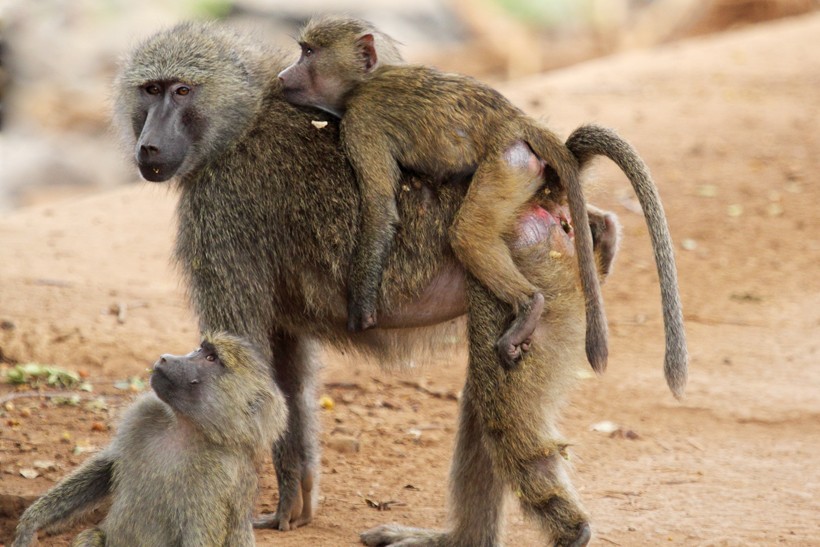
Mother baboon carrying her baby on the back
?
Image credits: MattiaATH/Shutterstock
Females are highly aggressive during this period, especially due to the presence of many males in the troop. The newborn baboon faces many dangers during the first year after birth. Males often kill young ones in order to mate with the mother. A baby baboon is quite small in size and, therefore, an easy potential prey for raptors, foxes, and snakes if the young one wanders too far away from the mother. Due to these dangers, the mother keeps the baby close to her as long as it is not capable of fending for itself.
After reaching adulthood, the threats of predations decrease by a huge margin for the olive baboon. In a favorable habitat, they can live for up to 25-30 years. Due to its wide distribution through Ethiopia and Guinea, the olive baboon range overlaps with other species of baboons such as hamadryas baboon, yellow baboon, and Guinea baboon. Hybrids have been reported and spotted several times, indicating that cross-breeding occurs wherever different species of baboon share the same habitat. However, no hybrids have been studied in detail and hence, only minimal information is available about the existence of olive baboon hybrids.
Behavior and Communication
Olive baboons live in large groups called troops or congress. They spend most of the time close to each other for protection; social grooming is an integral part of their social lifestyle. Although the group looks quite unorganized at the first glance, a closer observation reveals that olive baboons follow a complex hierarchy within the group. As males change troops very often in their lives, they are not a part of this existing hierarchy.
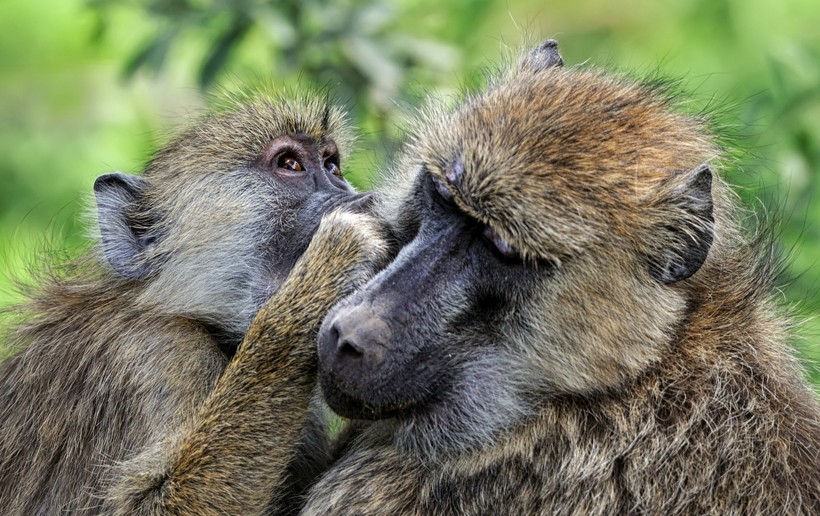
High ranked females are groomed very often by males and lower ranked females.
?
Image credits: Volodymyr Burdiak/Shutterstock
Females have a ranking system, where the high-ranked females enjoy more privileges than the lower ranked ones. High-ranked females reproduce at a younger age, are more fertile and their babies have a better chance of survival within the troop. Life is hard for the low ranked females. They are often driven off from good feeding and sleeping sites by the high ranked females. A low ranked female experiences the least amount of grooming while the high ranked ones are groomed very often by males and lower ranked females. Such complex hierarchy is very rare in the animal world. However, baboons seem to be flourishing very well within the structure they maintain.
Baboons use several modes of communication to deal with different situations in its lifetime. The olive baboons make a “wahoo” call to alarm the troop about approaching predators. This sound is also used to alert the group about neighboring troops. The “basic grunt” is the most frequently used sound. All ages and sexes produce this to express various common things. Another unique call is the “cough-bark”, which is a short barking sound, made to alert the group about small predators like birds of prey.
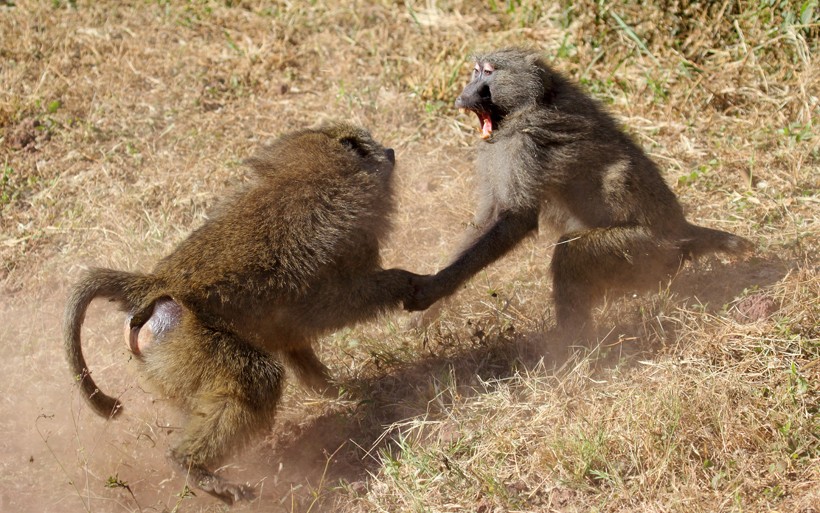
Male baboons fighting, serengeti national park Tanzania
?
Image credits: MattiaATH/Shutterstock
Males often produce a loud “roar grunt”, used to express dominance. This call can be heard frequently during the mating season when the males are in constant competition for mating rights.
The Olive baboon and African elephants exhibit a symbiotic relationship in the wild. Baboons use the water holes made by elephants and in return, the elephants depend on baboons for spotting predators.
Over the course of time, several tourists have reported baboons displaying a remarkable amount of intelligence. These primates can watch and learn new things very quickly. Researchers believe that group hunting behavior is one of their latest discoveries. It is believed that the hunting behavior began in one of the troops or among the males and, later on, it was spread to the entire population of olive baboons. Based on these complex social and behavioral characteristics, it is clear that baboons are quite intelligent animals, capable of surviving and flourishing in a land as rough as the African grasslands.
Population and Conservation
Olive baboons are found in a strip of 25 equatorial countries, starting from Guinea in the West to Ethiopia in the Far East of the African continent. Their population numbers are quite healthy at the moment. They are found in many protected areas and other manmade conservation facilities. The IUCN has enlisted this species under the category, “Least Concern”, as they are widespread and are found in large numbers throughout their range.
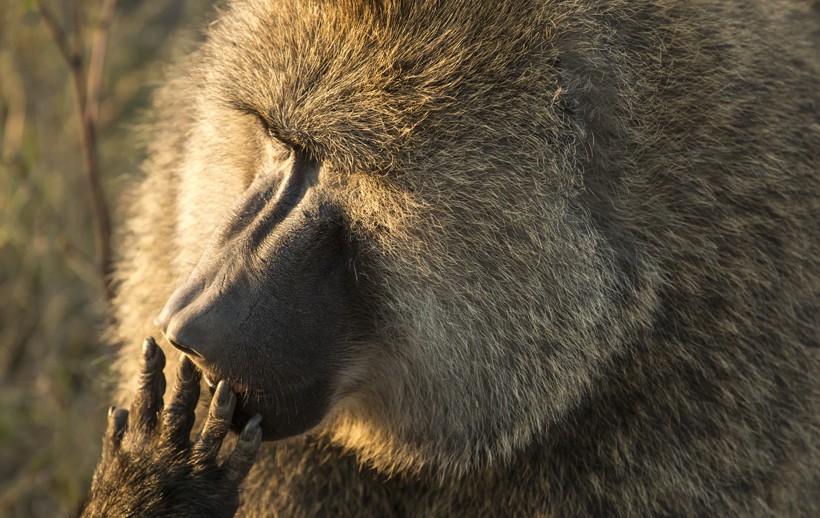
Olive baboon licking its fingers, serengeti national park, tanzania
?
Image credits: Karthik Veeramani/Shutterstock
Olive baboons have a notorious reputation for being aggressive towards humans. Troops inhabiting close to human settlements are known for crop raiding in the fields. Due to this behavior, humans in the region view these creatures as a pest species. Over the course of time, humans have conducted numerous hunting, poisoning and capturing campaigns on baboons, but the population numbers have not been affected so far.
However, loss of habitat and climate changes can pose a threat to this species in the future. With the rise in global temperatures, the climate in olive baboon habitat is getting drier every year. Due to this, water sources are being affected. Habitat loss, due to an enormous increase in human population, is also one of the major threats that may affect the olive baboon population in the near future.
Evolution
Olive baboons are primates of the family Cercopithecidae or Old World Monkeys. These monkeys share 91% DNA similarities with humans. Due to this, there are several debates regarding the evolution of this species.
Recently, two fossils were discovered from the East African Rift. One of them consisted of a humanoid species, Rukwapithecus fleaglei, which was more related to humans while the other one was a primate from the family Cercopithecidae. It was named Nsungwepithecus gunnelli. The taxonomic status of these species was determined by studying the mandible and tooth fragments that were preserved in the fossils. The fossils dated back to 25 million years, indicating that apes and the Old World Monkeys must have been split during the same time period.
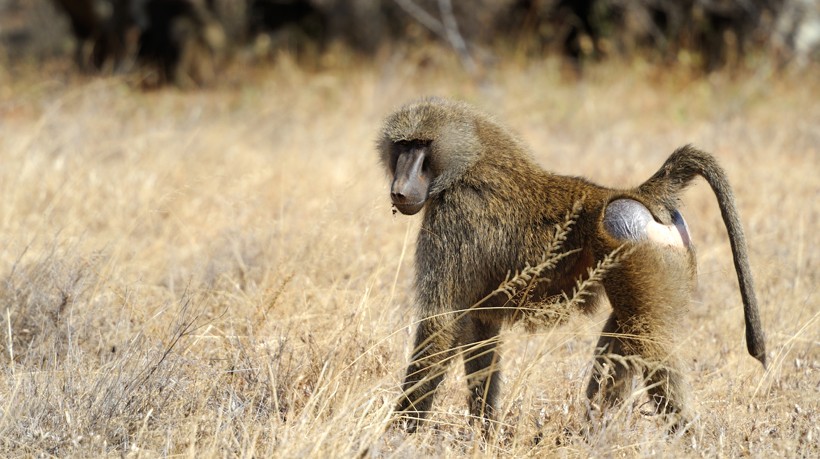
Olive baboon walking on the savanna
?
Image credits: Volodymyr Burdiak/Shutterstock
Regularly new discoveries are being made on the evolution of apes and humans. Therefore, there is a possibility that the previous speculations and theories may be proved wrong in future.
Funfacts
- Olive baboons and humans share 91% similar DNA
- Olive baboons are the most widespread species of baboons.
- These monkeys live in large groups being sometimes up to 150 members strong.
- A group of baboons is often referred to as a troop or congress.
- Large males can weigh up to 50 Kg.
- Olive baboons have canines that can be larger than that of lions.
- Olive baboons are omnivorous creatures. They can hunt down small prey when food is scarce.
- Olive baboons have a social hierarchy in their group, where the high-ranked females get more privileges than the lower ranked females.
- Olive baboons are highly aggressive and intelligent monkeys. They use their brains and sharp canines whenever the situation demands improvisation.
